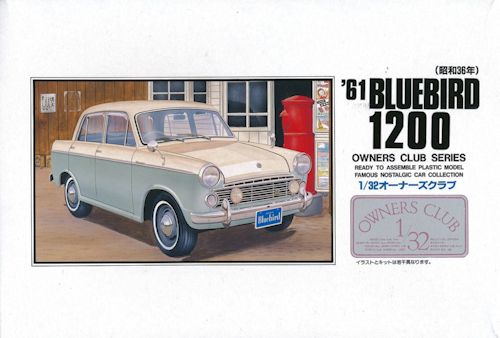
Arii 1/32 1961 Bluebird 1200
| KIT #: | 51007 |
| PRICE: | 600 yen when new |
| DECALS: | Yes |
| REVIEWER: | Scott Van Aken |
| NOTES: | Curbside |

| HISTORY |
_001.JPG/280px-Datsun_Bluebird_(310)_001.JPG)
The Datsun Bluebird which debuted in August 1959 was an all-new car, and was available in Japan at the dealership sales channel Nissan Bluebird Store. The 310 series had a 1 L engine from the 210 model. The 310 was built from 1960-1963. There were three models built: 310 (1960), 311 (1961), and 312 (1962–1963). In Taiwan it also replaced the 701 and was known as Yue Loong Bluebird 704. The Datsun 312 was also sold in Korea.The 310 series was also built in South Africa at a factory in Rosslyn Pretoria in CKD form during 1962 and 1963. The model was also sold in New Zealand and was one of the first Japanese models available there, beginning in May 1962.
In July 1960, a five-door station wagon was added (WP310). The P310 was powered by the 1.2L Nissan E engine. A smaller engine version (simply called "310") was powered by the 1.0L Nissan C engine. The P311 and P312 (powered by the 60 hp 1.2L Nissan E-1 engine) also had smaller engined versions ("311" and "312") that were powered by the 45 hp 1.0L Nissan C-1 engine. The 310 and 311 were equipped with a 3-speed manual transmission (fully synchronized for the 311 and 312). The station wagon was also available for the 311 and 312. The 312 was also available in a deluxe version (DP312). A trim model called the "Fancy Deluxe" (model code DP312-L) was marketed for the female driver; it featured a pale yellow exterior, pale yellow/grey interior, high heel shoe holder under the dash, a vanity mirror on the back of the driver's side sun visor, a turn signal relay that played music, curtains, automatic clutch, and bigger mirrors. By February 1961, a 1.2 L overhead-valve engine (codenamed E-1) became an option on a higher-trim DX model.
Styling tended to mimic larger American cars. A very small number did make it to the United States. This generation of Bluebird became one of the first Japanese cars to be sold in significant numbers in Europe, after Finland fully opened its doors to automobile imports in mid-1962. 700 were brought in, and by the time the 410-series had arrived, Datsun had passed SAAB and Triumph in registrations. Although not very fast, the sturdy Datsun was well-suited to the rugged Finnish roads of the time.
| THE KIT |
 As
some of you know, Arii is the reincarnation of the old LS models company which
went bankrupt. As a result, we are seeing many if not all of their older kits
being released under the Arii label. This is not a bad thing as LS was one of
the best smaller Japanese companies around.
As
some of you know, Arii is the reincarnation of the old LS models company which
went bankrupt. As a result, we are seeing many if not all of their older kits
being released under the Arii label. This is not a bad thing as LS was one of
the best smaller Japanese companies around.
If you have built any of these kits, you'll find things to be pretty familiar. First off, the parts are quite nicely molded. No engine, but a rather nicely done interior front and rear bench seats, interior side panels and an instrument panel with steering wheel. These fit either on the floor pan or on the inside of the body itself in the case of the dashboard. No instrument decals are provided so you'll have to resort to paint.
The chassis pan accepts the front and rear suspension pieces and an exhaust pipe and muffler. Wheels are a single piece and slip onto rubber tires. On the outside are a separate grille, bumpers, lights, wipers and mirrors. No chrome parts are included so you'll have to resort to paint or Bare Metal Foil for these. I plan on using Alclad II Chrome which looks very good, though is a bit fragile in terms of a lot of handling. I should also point out that the white stripe on the tires will have to be painted if you want them on your model.
| CONCLUSIONS |
This is actually the second one of these cars I've previewed, having done the police version a few years back. There are some detail differences, but not many. These are nice car kits with few issues aside from the lack of chrome plated parts. 1/32 scale means they won't take up a lot of display space!
| REFERENCES |
http://en.wikipedia.org/wiki/Nissan_Bluebird
March 2014 Thanks to me for getting this one to share with
you. If you would like your product reviewed fairly and fairly quickly, please
contact
the editor or see other details in the
Note to
Contributors.